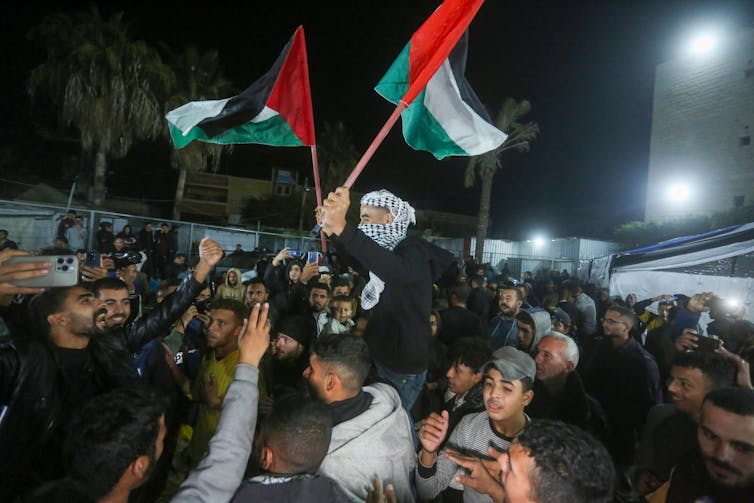The much-anticipated ceasefire and hostage agreement in Gaza will come into effect on January 19, 2025, subject to a vote on the package scheduled for the morning of January 16 by the Israeli government.
The breakthrough comes 15 months after a bloody conflict sparked by an attack by Hamas gunmen on October 7, 2023, which killed some 1,200 Israelis and took 251 hostages. In the subsequent bombing and siege of Gaza, some 45,000 Palestinians were killed.
But why is the breakthrough happening now? What does this mean for the long-term prospects for a more lasting peace? The Conversation turned to Asher Kaufman, an expert on Israeli history and professor of peace studies at the University of Notre Dame, for answers.
What is the main content of the transaction?
Not all details have been resolved or released. But what we do know is:
The transaction is divided into three phases. In the first phase, 33 women, children and men who are sick or over 55 years old will be released in stages within 42 days. The hostages, including two U.S. citizens, are believed to have been held by Hamas in a network of tunnels beneath Gaza since October 7. A total of 94 hostages remain in custody, 34 of whom are believed to be dead.
The Israeli military will also allow Palestinians who were forced to leave northern Gaza to return, even though much of the area and their homes are in complete ruins.
On the 16th day of the agreement's implementation, negotiations will begin on the next phase of the agreement, which will include the release of the remaining hostages held by Hamas. As part of this phase, Israel will withdraw its forces to a defensive belt that will serve as a buffer zone between the Gaza Strip and Israel.

In exchange for the release of the hostages, Israel would release Palestinian prisoners in accordance with an agreed ratio of dead or alive civilian or soldier hostages to Israel. In the first wave, hundreds of Palestinian women and children currently held in Israeli prisons will be released. Additionally, Israel will allow more humanitarian aid to flow into Gaza.
The third phase of the agreement will include the release of the remaining dead hostages and focus on the reconstruction of Gaza under the supervision of Egypt, Qatar and the United Nations. At this stage, Israel is expected to fully withdraw from the Gaza Strip.
How important is this breakthrough?
Fifteen months of war have been devastating to Gaza. The agreement opens up the possibility of an end to the fighting there and could be the first step towards reconstruction and stabilization of the Palestinian enclave.
It would also allow the incoming Trump administration to focus on other issues more central to its foreign policy agenda, such as a potential new deal with Iran and the resumption of normalization talks between Israel and Saudi Arabia, issues related to establishing a new 's security alliance with the United States
For Israel, it means the possibility of ending its longest war, which has cost a fortune, weakened its international standing and left its society deeply divided between supporters and opponents of the government. It could end the state of emergency in effect since October 7, 2023, allowing Israeli society to begin its own recovery.
What questions remain open?
There are big question marks in the later stages of the deal. Key members of Prime Minister Benjamin Netanyahu's coalition, including National Security Minister Itamar Bengvir and Finance Minister Bezalel Smotrich, have been accused of being more interested in permanently occupying the Gaza Strip than freeing hostages . They are therefore unwilling to agree to any measures that would lead to the handing over of the enclave's governance and security to the Palestinians.
Throughout the conflict, the Israeli government has made clear that it does not want Hamas to play any role in a post-conflict Gaza. But Hamas's main rival, the Palestinian Authority, has little credibility among Gaza residents. Who will rule Gaza leaves an open question.
There are also concerns that if Israel is truly interested in fully implementing the deal, it may strike a deal that includes a complete withdrawal from Gaza in exchange for the release of all hostages, rather than one that is implemented in stages.
Why are negotiations now successful while previous attempts failed?
The agreement has been on the table since at least May 2024. But Netanyahu and his government have consistently opposed the deal, largely because they want Israel to retain control of Gaza.
Some of his government ministers also want to establish Jewish settlements in the Gaza Strip and have made it clear that they want to create conditions for reducing the number of Palestinians in the Strip.
Netanyahu's critics also say the prime minister wants to prolong the war as long as possible because it benefits him politically.
But the election of Donald Trump as U.S. president changed the dynamics between Israel, Hamas and the U.S.
Trump wants to be seen as a dealmaker on the global stage, and Netanyahu, a close Republican ally, is inclined to help Trump on the matter. The timing of the deal allows Trump to gain ground while also allowing Joe Biden to leave office with a foreign policy "victory."

Israel also wants a deal that clears the way for the resumption of normalization talks between Israel and Saudi Arabia - a process that was launched under Trump's first administration.
Netanyahu may be betting on a deal with Saudi Arabia to balance his tarnished reputation at home as the Israeli leader who was in power at the time of the Oct. 7 massacre.
How will the deal play out in Israel's fractious politics?
That's the big question that will determine the deal's fate in the long run.
Its terms are fundamentally contrary to the wishes of many members of Netanyahu's ruling coalition - and they may do all they can to undermine it.
It is unclear whether these right-wing die-hards will quit the government or remain in the coalition because they believe later stages of the deal will not be implemented.
What does this mean for the future of Hamas and its role in Gaza?
The agreement did not specify the conditions for replacing Hamas' rule in Gaza.
Netanyahu has so far opposed any efforts to promote the return of the Palestinian Authority or allow any other Arab or international consortium to manage civil affairs in the strip.
Hamas has no intention of pushing for its replacement by another governing body and relinquishing control of Gaza. However, the militant group's position has weakened compared to before October 7 due to the loss of key leadership members over the course of the war.
A cynical view might be that it might actually be in Netanyahu's interest to keep a weakened Hamas in power, allowing him to manage the Israeli-Palestinian conflict rather than try to resolve it. This was his approach before October 7, and there is no sign that it has changed.